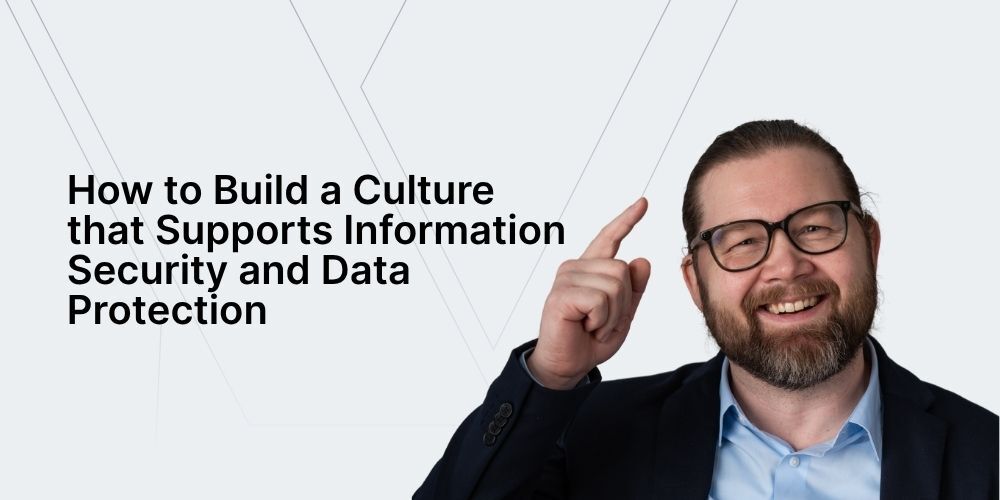How to build a culture that supports information security and data protection

Here are some practical tips for creating a strong culture that supports your efforts in information security and data protection.
The situation in many organisations
Risk and compliance efforts often turn into paper tigers — existing mostly within the realms of compliance or information security departments.
The core problem
If you want to achieve genuine protection and robust security, employees need to be brought on board. In practice, it’s HR, marketing and frontline staff who make the everyday decisions — big and small — that either improve or weaken your organisation’s security.
The impact on the business
The organisation misses out on the return of its investments in information security and data protection. Instead, GRC is viewed purely as a cost — something to be minimised as much as possible.
Pro Tip:
GRC can actually support strategic business goals — from faster sales cycles to improved customer satisfaction. Read more in this article:
3 steps to make GRC, information security and data protection strategic
The Impact on You
If you often feel that neither management nor colleagues appreciate your work, it's likely a symptom of a missing or poor GRC culture.
We often hear from professionals working in information security and data protection that they feel stressed and burned out.
That, unfortunately, is the ultimate consequence.
So let’s change that. Let’s build a healthy, supportive culture and bring more satisfaction to our daily work.
But first, let’s zoom out a bit.
Why culture matters
Preventing human error
Most security - and data breaches stem from human mistakes.
Making security everyone’s responsibility
When your receptionist double-checks an email before sending personal data to the wrong address — that’s good data protection.
When your finance officer avoids clicking a phishing link in a fake invoice — that’s sound information security.
Security is everyone’s job.
Faster threat detection
When employees consider security in their everyday decisions, they’re more likely to spot threats early and help reduce harm.
Strengthened resilience
A culture that encourages incident transparency and proactive response helps reduce stress and builds the organisation’s ability to recover from setbacks.
Effective compliance and governance
A strong GRC culture makes it easier to meet standards like the GDPR by embedding compliance into everyday routines, rather than just documents.
Confidence for new joiners
Onboarding that includes engaging, continuous training — and a culture free from blame — encourages reporting and learning from mistakes.
You can probably add a few benefits of your own.
{{factbox-dark}}
How to build that culture
Get leadership on board
Executive buy-in and visible role-modelling from leadership signal that security is valued and prioritised. That’s your first step: leadership must come along for the ride.
Focus on skills, not just knowledge
Most companies offer awareness training — often focused on GDPR or security basics. But think in terms of capabilities. What do you actually want your colleagues to be able to do, not just know?
Use stories, not just stats
People remember stories. And there are plenty out there about the real-life consequences of security and data breaches. Share those stories with your colleagues to help them understand the true impact of their actions — and motivate better behaviour.
Keep procedures simple and accessible
Your job is to make it easy to reduce risk and follow the rules. That means understanding how your colleagues work and helping them build good habits around information security and data protection.
Reward and recognise good security habits
Acknowledge employees who spot issues, follow best practices, or avoid phishing attempts for example, with internal shout-outs or small tokens of appreciation.
5 trends to turn fragile data protection and infosec into sustainable GRC programmes.
The trends are:
- Trend #1 From centralised authority to company-wide collaboration
- Trend #2 From tick-the-box compliance to balanced decision-making
- Trend #3 From problem-oriented to solution-oriented
- Trend #4 From legal thinking to strategic involvement
- Trend #5 From managing data subject to caring about people
🧠 Dive into all five trends in our free e-book:
Five Trends Shaping the future of Information Security and Data Protection
💥 Sick of managing security alone?
You don’t have to carry the burden of information security and data protection on your own. Discover how others have broken down silos and created a culture where the entire organisation takes responsibility — and where GRC actively supports the business.


.webp)




.jpg)